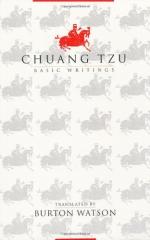|
This section contains 7,496 words (approx. 25 pages at 300 words per page) |

|
SOURCE: Meishi Tsai. “The Taoist Imagination: Chuang Tzu's Aesthetic Intimations.” Tamkang Review XI, no. 3 (spring 1981): 226-48.
In the following essay, Meishi compares Chuang Tzu's philosophy of the reconciliation of opposites, the interdependency of objective and subjective, and the equality in being of all things to the English Romantic poets' aesthetic of the unity of imagination and reality.
I
In order to demonstrate Chuang Tzu's creative imagination, it is necessary to turn to the concept of Tao and its manifestation in the Taoist philosophy. Prior to Chuang Tzu, Lao Tzu in his Tao Te Ching had already expounded Tao as a formless, nameless, all-embracing first principle. To describe Nonbeing as the creative potential, Lao Tzu uses the epithets of i (elusive), hsi (rarefied), and wei (infinitesimal). The inscrutable mystery of Tao, the shapeless shape, formless form, lies in the metaphysical “emptiness”:
Such [is] the scope of All-pervading Power That...
|
This section contains 7,496 words (approx. 25 pages at 300 words per page) |

|


